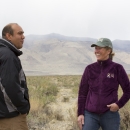About Us
The field office emphasizes an ecosystem approach incorporating Strategic Habitat Conservation to address and prioritize habitat issues through partnerships with other federal and state agencies, conservation organizations, private landowners, and citizens to achieve the greatest possible benefits to fish and wildlife.
What We Do
Our team will utilize all available resources and opportunities to multiply our successes on species recovery and strategic habitat conservation. We will seek out and create new opportunities to engage our key partners and private landowners in strategic conservation efforts with a goal of de listing, down listing, and preventing the listing of species in Louisiana.
Our Organization
As a field office of the U.S. Fish and Wildlife Service, we are charged with implementing certain Service's programs. Below you'll find a list, with links to more information about the programs we carryout in the State of Louisiana.
Threatened & Endangered Species
Coastal Restoration
Partners for Fish & Wildlife
Federal Projects
Administrative Services
Geospatial Data Services
More Information About Our National Programs
Our Species
We work to protect federal threatened and endangered species that are present in Louisiana. Learn more about the species that are the focus of our conservation efforts.
Projects and Research
Our team utilize all available resources and opportunities to multiply our successes on species recovery and strategic habitat conservation. We will seek out and create new opportunities to engage our key partners and private landowners in strategic conservation efforts with a goal of de listing, down listing, and preventing the listing of species in Louisiana.


















